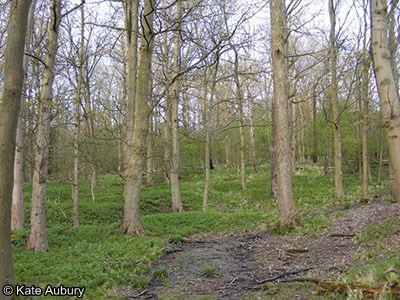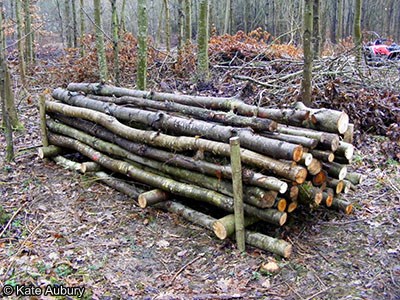| |
| Lowland Mixed Deciduous Woodland is a priority habitat under the UK Biodiversity Action Plan (BAP), spanning a variety of distinctive woodland types, reflecting differences in soil and topographical conditions. It is broadly characterised by the predominance of native broadleaf tree and shrub species. The Trust owns or assists in the management of a number of important woodland sites. |
 Bluebells, Kemerton Wood Bluebells, Kemerton Wood
|
 Stoat Stoat
|
Aldwick Wood SSSI
Owned by Kemerton Estate, Aldwick wood on Bredon Hill is a 27 acre (11 ha) area of Ancient Semi-Natural Woodland (dating from pre-1600). It has been designated SSSI and SAC as it provides habitat for nationally important insect fauna associated with decaying timber, in particular the violet click beetle. The tree layer is dominated by ash, sycamore and common oak, with a shrub layer of hazel, hawthorn and elder. The ground flora is composed mainly of nettle, dog’s mercury, wild garlic and common dog-violet. The wood is also extremely rich in fungi. Many bird species breed here, including song thrush, buzzard, great spotted woodpecker, tawny owl, blackcap, willow warbler and chiffchaff. In winter, large numbers of redwing, fieldfare and mistle thrush roost here. Redstart and pied flycatcher occasionally pass through the wood on migration, while black kite has also been recorded here. Management includes the staged removal of sycamore, the planting of common oak grown from local acorns, and the construction of deer exclosures to promote natural regeneration. Many dead trees are left standing to provide habitat for dead-wood beetles. |
 Aldwick Wood SSI Aldwick Wood SSI
|
| |
|
Kemerton Wood & Arboretum
The Trust assists in the management of Kemerton Wood and Arboretum, 111 acres (45 ha) of plantation woodland between Bredon and Kemerton. The wood was planted gradually in small blocks between 1968 and 2009. The species composition is dominated by native broadleaf species such as common oak, ash, birch, beech, cherry, alder, lime, field maple and hazel. Within the woodland is a collection of ‘exotic’ trees, many of which are scarce or threatened in their native environments. They have been grown from seeds collected in the wild, and planted out along paths and rides in Kemerton Wood.
As Kemerton Wood is a relatively young plantation, it has not yet developed the complex biodiversity characteristic of ancient woodland. The Trust has been helping to accelerate this process by under-planting trees with locally native shrub species, such as guelder rose, hawthorn, yew, holly, spindle, privet and elder. It has also conducted experiments into enriching the field layer, by introducing leaf litter containing seeds, fungal spores, invertebrates and microbes from nearby ancient woodland. For more information, please visit the ‘Leaf litter trials’ section on our Surveys & research page. The Trust also maintains log piles and beetle lodges as well bird and bat boxes, to encourage a more diverse fauna. |
 Beetle Lodge, Kemerton Wood Beetle Lodge, Kemerton Wood
|

Bat Box, Kemerton Wood
|
| |
|
Tree Nursery
The Trust manages a nursery for propagating native trees, shrubs and wildflowers. Seeds are collected locally for use in the Trust’s reserves. A careful record is kept of collection sites and dates, as well as of planting dates and locations. At its peak (1999-2000) the nursery propagated around 500 trees and shrubs per year. |
 Trees grown by KCT in our Tree Nursery Trees grown by KCT in our Tree Nursery
|
Back to
Map
|
|














